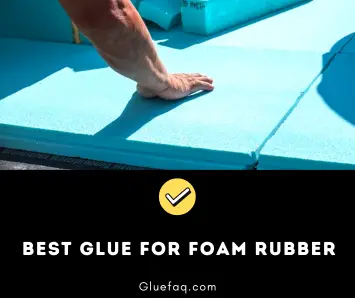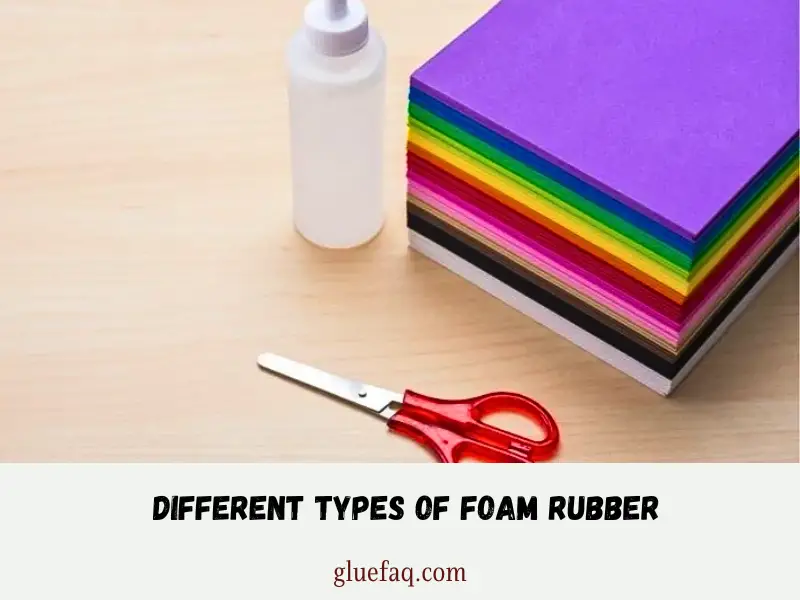Welcome to the ultimate guide on glue for foam rubber! In this comprehensive article, we will explore the various aspects of gluing foam rubber, from the importance of choosing the right adhesive to practical tips for successful bonding.

Whether you’re working on a DIY project or a professional application, understanding the nuances of foam rubber glue will ensure durable and long-lasting results.
Glue for Foam Rubber
Foam rubber serves as a versatile material in numerous applications, providing cushioning, insulation, and support. However, without the right glue, the effectiveness of foam rubber can be compromised.
Choosing the appropriate adhesive is crucial for ensuring a strong and durable bond that withstands daily use and environmental factors.
Types of Foam Rubber
Foam can be found in many places, like the soft padding on sofas and the boards at the head of beds, as well as in-car cushions and bumper cores.
It has various uses, such as providing insulation for warmth, reducing noise from footsteps, and being used for packaging.

Let us take a close look at foam types in a little more detail.
1-Polyurethane Foam
Lightweight and flexible, polyurethane foam offers excellent cushioning and shock absorption.
Commonly used in mattresses, upholstery, and automotive seating.
2-Neoprene Foam
Neoprene foam exhibits excellent resistance to oil, chemicals, and extreme weather conditions.
Frequently utilized in gaskets, seals, and outdoor applications.
3-Latex Foam
Latex foam provides exceptional comfort and support, often found in bedding products and furniture cushions.
Its natural elasticity makes it ideal for applications requiring repeated compression and decompression.
4-Charcoal Foams
This foam is really versatile, and you’ve probably come across it in your daily life. When you buy and store things like computers, cameras, and guns, you’ll see that the cases are lined with charcoal foam.
5-High-Density Foam
This type of foam is commonly found in mattresses, sofas, cushions, boats, and camping gear. It is a medium-grade foam often used in these products.
6-Memory Foams
Memory foam is a special kind of foam used for making cozy beds and pillows. It molds itself to your body shape and offers support while you sleep. Interestingly, this high-quality foam was first developed for seating in space shuttles.
Factors to Consider When Choosing Foam Rubber Glue
Selecting the right adhesive for foam rubber involves considering several crucial factors:
- Bond Strength and Durability
- Compatibility with Foam Rubber Types
- Application Method and Drying Time
- Safety and Environmental Considerations
Popular Glue Options for Foam Rubber

Spray Adhesive – 3M Foam Fast Spray Adhesive
Convenient and easy to use, spray adhesives provide even coverage and fast bonding.
Specifications
- Brand: 3M
- Product Name: 3M Foam Fast Spray Adhesive
- Adhesive Type: Spray Adhesive
- Suitable for: Bonding foam, fabric, plastics, and other lightweight materials
- Fast-drying formula: Provides quick adhesion and reduces waiting time
- High strength: Creates a strong and durable bond
- Versatile application: Ideal for crafts, upholstery, home decor, automotive, and other projects
- Bonding Range: Offers a long open time for repositioning and adjusting before setting
- Heat-resistant: Can withstand elevated temperatures for added durability
- Dispensing Method: Aerosol spray for easy and precise application
- Size: Available in various can sizes for different project needs
- User-friendly: Provides a controlled and even spray pattern for smooth and efficient application
- Low-mist formula: Minimizes overspray and reduces mess during use
- Suitable for both indoor and outdoor use
Note: It’s always recommended to read and follow the product instructions and safety guidelines provided by the manufacturer.
Pros
- Dries fast
- Secure Flexible
- Can stick foam to various surfaces
- Withstands different weather conditions and aging
- Sturdy and extremely durable Becomes unnoticeable after drying Produces
- minimal spray residue
Cons
- This product might cause harm to the environment.
- It is not possible to completely prevent the release of spray mist.
Contact Cement – WELDWOOD Original Contact Cement
Contact cement offers a strong, permanent bond suitable for larger foam rubber projects.
Specifications
- Brand: WELDWOOD
- Product Name: Original Contact Cement
- Type: Contact Cement (Adhesive)
- Application: Ideal for bonding a wide range of materials, including laminates, veneers, plywood, leather, rubber, metal, and more.
- Strength: Offers a strong and durable bond.
- Drying Time: Fast-drying formula with a short tack time, allowing for efficient bonding.
- Heat Resistance: Provides heat resistance, making it suitable for applications that may be exposed to high temperatures.
- Waterproof: Once cured, it offers resistance to water, ensuring durability in various environments.
- Versatility: Suitable for both indoor and outdoor applications.
- Size Options: Available in various sizes to accommodate different project needs.
- Usage: Commonly used in woodworking, construction, automotive, and crafts projects.
- Application Method: Typically applied using a brush or roller to both surfaces being bonded.
- Storage: Should be stored in a cool, dry place, away from direct sunlight.
Remember to refer to the specific product label or manufacturer’s instructions for detailed usage guidelines, safety precautions, and any additional information related to the Contact Cement – WELDWOOD Original Contact Cement.
Pros
- Easy to use
- Works well with various materials Creates a flexible and gentle seam
- Can be applied on just one side
- Creates a powerful and long-lasting bond
Cons
- Fumes can cause harm.
The Best Foam Adhesive – BEACON Hold The Foam
Special adhesives for foams are designed specifically to bond different types of foam together. These adhesives work well with various kinds of foam materials.
Specifications
- Size: Available in 2 oz and 4 oz options.
- Brand: BEACON.
- Material: Foam, Paper, Plastic.
- Compatible Materials: Wood, Cardboard, Paper.
- Item Form: Solid.
- Special Feature: Glitter.
- Key Features:
- Instant grab for quick and secure bonding.
- Repositionable for easy adjustments before setting.
- Water clean-up for hassle-free maintenance.
- Non-toxic, ensuring safety during use.
- Origin: Made in the USA.
- Usage: Specifically formulated to bond different types of foam, including styrofoam plastic foam.
- Bottle Size: Comes in a convenient 2 oz bottle.
- Safety: Non-flammable and adheres to safety regulations.
Pros
- Includes a brush for easy application
- Can withstand different temperatures
- Can be washed
- Bonds foam to various surfaces
- Resistant to water, oil, and acids
- Very flexible and soft
- Suitable for a wide range of foam types
Cons
- It has a powerful smell
- it should be used outdoors while wearing a mask
How to Glue Foam Rubber
Follow these easy steps for successful foam rubber gluing:
- Preparing the Workspace
- Applying the Glue
- Bonding Foam Rubber Together
- Allowance for Drying and Curing
Proper Preparation for Gluing Foam Rubber
To achieve optimal bonding results, adequate preparation is essential. Follow these steps:
- Surface Cleaning and Preparation
- Test Fitting and Alignment
- Applying Primers or Surface Activators
Tips and Tricks for Successful Foam Rubber Gluing
Enhance your gluing experience with these expert tips:
- Using Clamps or Weights for Pressure
- Applying Multiple Thin Layers of Glue
- Considering Temperature and Humidity Factors
Common Challenges and Troubleshooting
Encounter any issues during the gluing process? Here’s how to troubleshoot common problems:
- Uneven Bonding or Gaps
- Glue Stains or Excess Glue
- Foam Rubber Detachment or Peeling
Best Practices for Glue Storage and Shelf Life
To maintain the adhesive’s effectiveness, follow these storage guidelines:
- Proper Storage Conditions
- Shelf Life of Different Glue Types
Safety Precautions and Protective Measures
Ensure your safety and handle glue responsibly:
- Proper Ventilation and Personal Protective Equipment (PPE)
- Handling and Storage Safety
- Disposal of Glue and Cleaning Tools
FAQs About Glue For Foam Rubber
It is generally not recommended to use regular glue for foam rubber. Foam rubber requires a specific adhesive for porous materials like foam. Using regular glue may not provide a strong and durable bond.
The drying time of foam rubber glue can vary depending on the specific adhesive you use. Generally, it can take anywhere from a few minutes to a few hours for the glue to dry completely. It is best to refer to the instructions provided by the manufacturer of the adhesive for specific drying times.
In most cases, it is possible to remove glued foam rubber. However, the ease of removal can depend on the type of adhesive used. Some adhesives may leave residue or damage the foam rubber during removal. It is recommended to follow the instructions provided by the adhesive manufacturer for safe removal or consult a professional if you are unsure.
Conclusion
By understanding the importance of glue for foam rubber and following the guidelines provided in this comprehensive guide, you can achieve strong and long-lasting bonds in your foam rubber projects.
Choose the right adhesive, prepare the surface properly, and follow the step-by-step instructions for successful gluing.
With the right techniques and tools at hand, you’ll be amazed at what you can create using foam rubber and the appropriate glue. Happy bonding!
